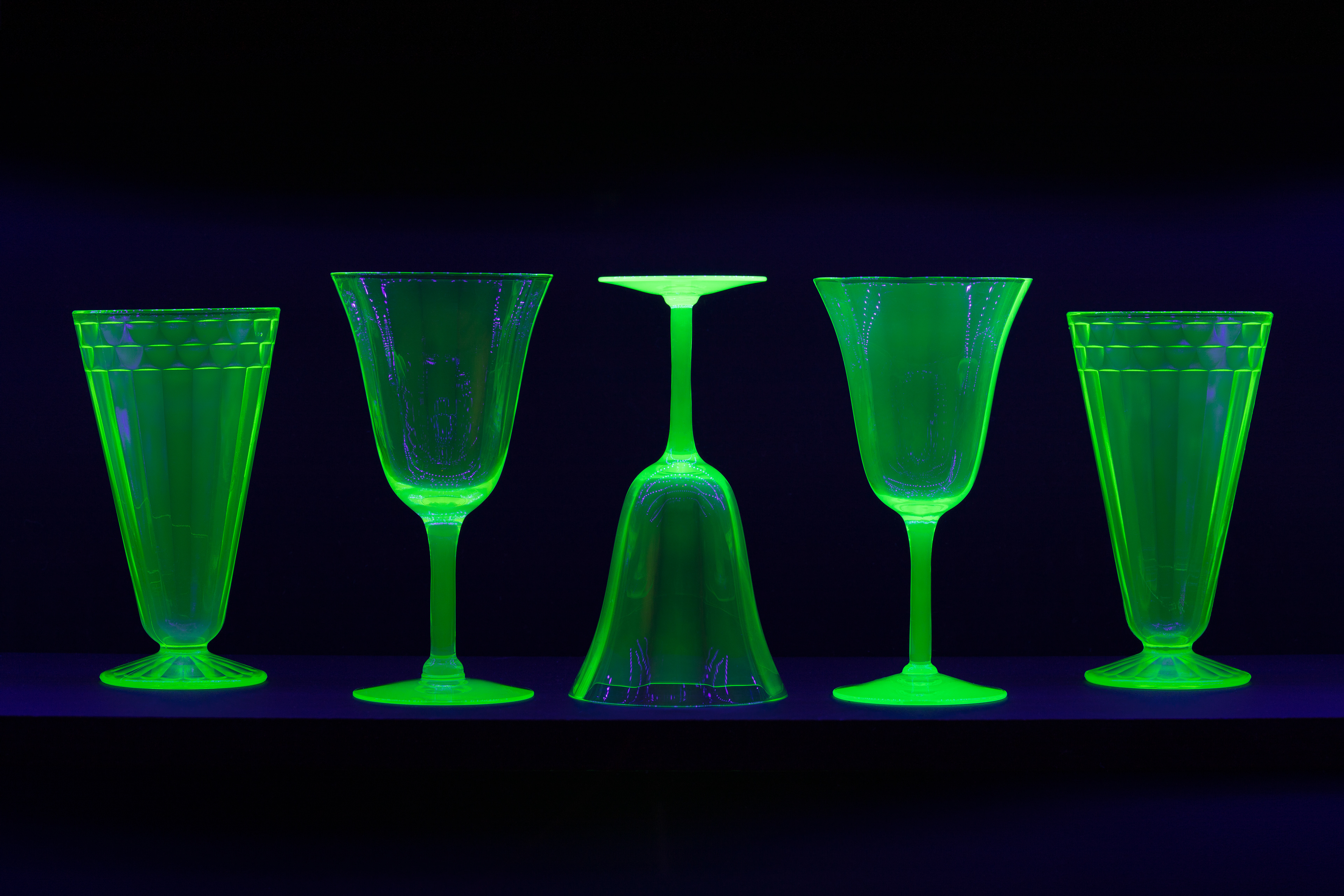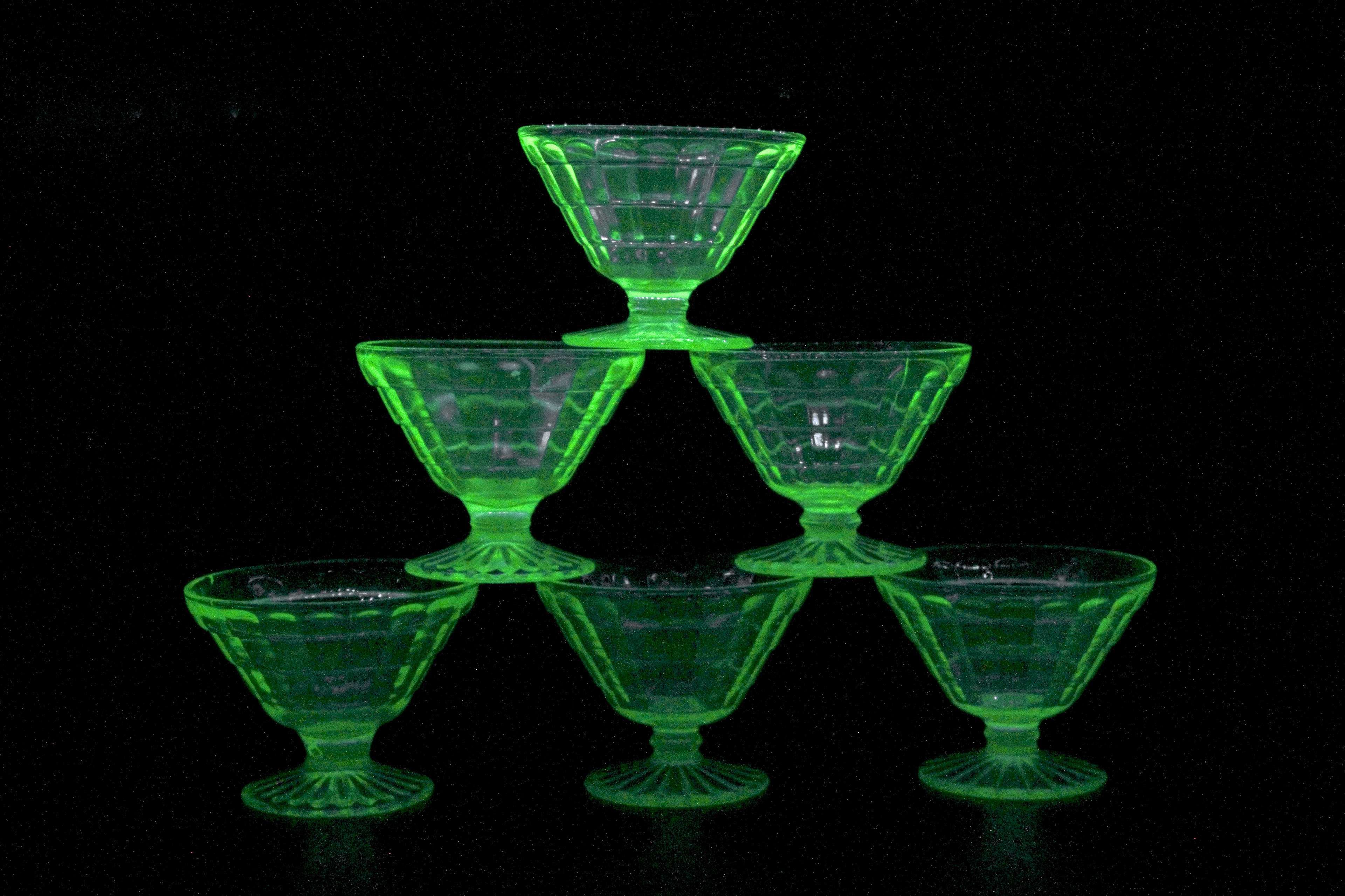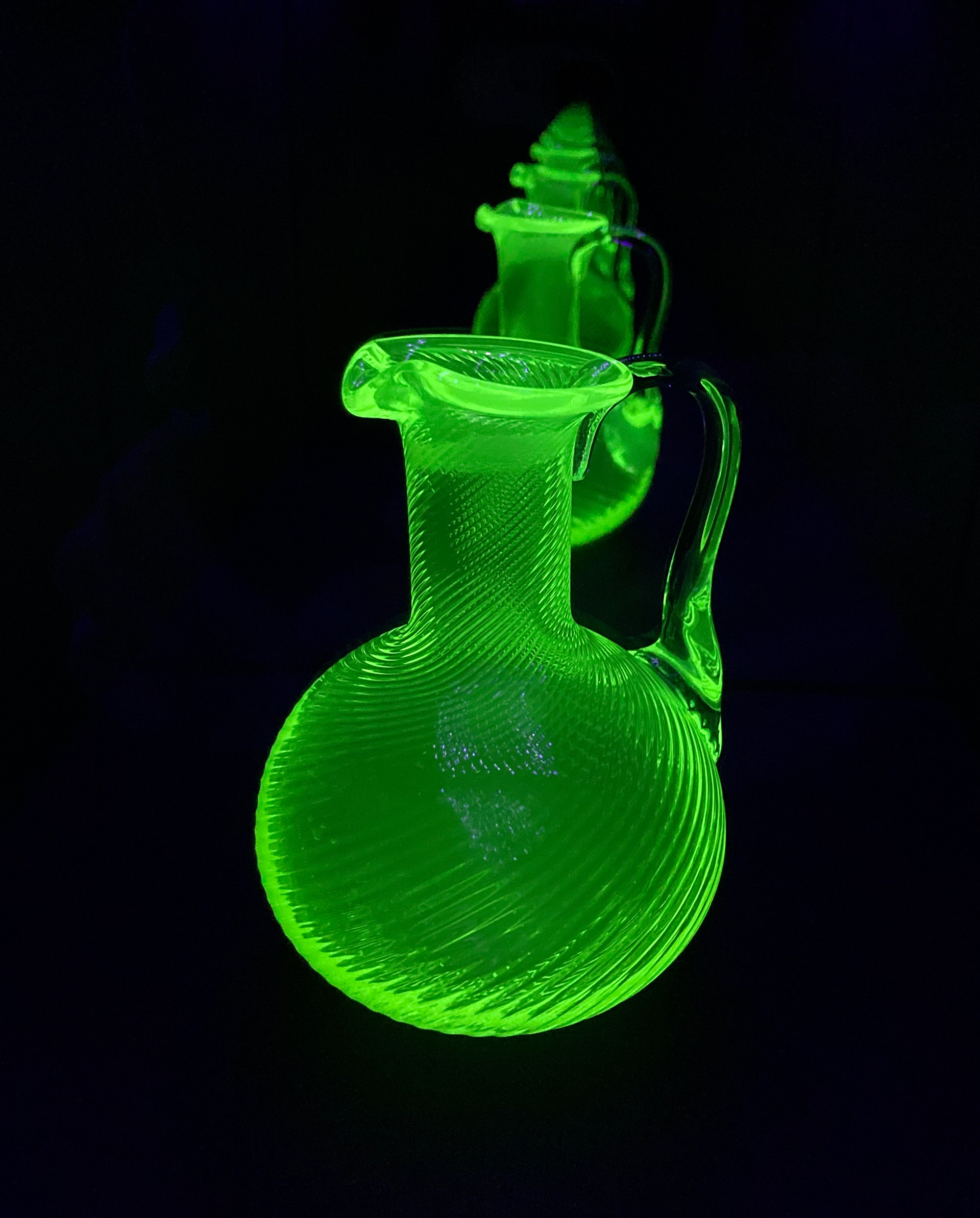test of faith, antique Depression-era uranium glass, wood, LED UV lights, 3-channel digital video installation with 5.1 surround sound. Specifically designed for and installed at The Bass Museum of Art, 2022. Image courtesy of The Bass.
the video
From 1951-62, there were 100 atmospheric atomic bomb tests conducted at the Nevada Test Site, just 65 miles from Las Vegas and less than 150 miles from where my mother and grandmother grew up, some many times larger than the bombs dropped on Japan. Tens of thousands of films were taken of these tests on super sensitive film stock to collect data and to preserve and document the development of the US nuclear arsenal.
Footage of nuclear test detonations was collected since the onset of testing, with the Trinity test (Alamogordo, New Mexico, July 16 1945). I find some interesting layers of complexity to the relationship film has with weapons development, both in terms of the actual filming of the events to how they impacted culture. Capturing the spectacle of testing was an endangerment of the camera operators—especially in the early days when the radioactive fallout was purportedly not fully comprehended—though we have come to learn data, impact and warning was suppressed in secrecy for decades and remediation and reparation has been meager and rife with injustice. Like many downwind civilians near test sites, many of these filmmakers fell ill with cancers. Although their work was perhaps the most important in terms of making this awesome and awful endeavor visible, and documenting this dark period of history—they themselves, along with many of the films—remained hidden for decades, (like much of the covert development of weapons itself). Shot on film, not only was this footage vulnerable to radiation at the time of shooting, but has also deteriorated over the years, threatening to fade away and turn to dust in secured vaults along with the history itself.
Over the last couple of decades more and more of these films have made their way to the public eye—in large part due to declassification efforts made in the hopes of raising awareness about the magnitude of destruction these weapons wield, and to carry the message: never again. The footage—which is most cases is accompanied only by a thick silence —is inevitably entrancing. When the world first saw images of the tests—blooming clouds morphing into undulating forms at a scale never before seen—the mesmerization perhaps distracted from the harm. Images and footage were used in sci-fi comic books and cinema, and turned up in advertisements and pop culture and an otherworldly fascination, something of a cult interest in the image of the bomb developed. The reality of the radiation and far-reaching impacts was not yet known or soon forgotten. What was etched into the culture was the spectacle and not the insidious tiny particles that were seared into history. The power of images and moving picture asserts itself here in a somewhat confounding way. Full of dust and scratches, these films bear the marks of an era of particular technological development. One that broke barriers at both micro-and macroscopic scales—from the subatomic to the extra-planetary. And like isotopes, these films physically decay.
I have used some of this footage, specifically films of nuclear weapons tests at the Nevada Test Site that were recently restored, digitized and declassified by the Lawrence Livermore National Laboratory to create a more psychological abstraction—Rorschachs of the deepest darkest type. Like the guise of military supremacy and the patriotic appeal that was made to largely Mormon settlers in the Utah fallout region where my family resided, but also the country as a whole, to support the effort and bear witness to these amazing technological advancements in science during the Cold War development program, their splendor deeply betrays the harm. I created a layered version of a Mormon hymnal “Love one another” for the soundtrack.
test of faith 3-channel video installation detail, New Mexico State University Museum of Art, 2023. Image courtesy of Byron Flesher
test of faith, antique Depression-era uranium glass, wood, LED UV lights, 3-channel digital video installation. Specifically designed for and installed at Orlando Museum of Art, 2023
test of faith detail of 3-channel video installation. 26x26x26ft, Orlando Museum of Art, 2023. Image courtesy of Orlando Museum of Art
test of faith installation details at NMSU Art Museum, 2023. Images courtesy of Byron Flesher.
test of faith




The installation of test of faith features curio cabinets of sorts containing mass-produced Depression Era glass dishes and decorative objects that contain uranium oxide as a colorant. At the onset of the Manhattan Project in 1942, all uses of domestic uranium—including to tint glass—were banned. I chose Art Deco-style pieces and arranged them architecturally, I nod to the aspirations of the glittering era just before the curtain came down and reference cinematic and symmetrical sets such as the Wizard of Oz and Kubrick. The acid green and vaseline yellow glass fluoresces in UV light, glowing a brilliant green in the lined cabinets.
The ready-mades feel aspirational, fraught, fragile, beautiful, foreboding and even a little menacing or dangerous, all at once to me. These consolidated artifacts document imperialism, colonialism, nuclearism and economy while still speaking to everyday domestic life. Now people love collecting it. The installations are a glimpse into the ghostly, quasi-spiritual, otherworldly dark shared connection that quite literally radiated out from the day we first tested and continues to haunt the bodies of every living thing on the planet.
test of faith, specifically designed and installed for Specter New Mexico at the NMSU Art Museum, 2023
and the desert shall blossom as the rose, Wood, mirror, antique Depression-Era glass, UV lights.
65 x 20 x 10 in. 2022. Image courtesy of The Bass.
65 x 20 x 10 in. 2022. Image courtesy of The Bass.
test of faith is part of a recent body of work that explores nuclear weapons development—including the muted history of testing and uranium mining in the American west. Using the midcentury Atomic Age as a lens to interpret the present looming threat of nuclear war, I reframe ready-mades and archives to remind of the irreversible consequences and convey the latent psychic imprint and cultural memory left in the wake of weapons development and testing.
The ghostly, cinematic staging of works in exhibitions Specter at the Bass Museum of Art (2022) and Specter New Mexico at the New Mexico State University Art Museum (2023) provides historical context as well as a haunting reminder of the obscured history and hidden injustice buried in the legacy of the Cold War. Impacts from both domestic uranium mining and atomic weapons testing were particularly devastating in my home region of the Colorado Plateau (encompassing parts of Utah, Navajo Nation, Colorado, Arizona and New Mexico), but reverberate across the entire globe to this day. Starting with the micro— my own family history, adjacent local histories and living memory — Despain threads together parallel and hidden narratives, arriving at a macro view of the literal and figurative fallout of the nation’s push for global military supremacy. It is an atmospheric monument to having irrevocably crossed the threshold into the Anthropocene, and into a nuclear age that continues to push us to an existential precipice.